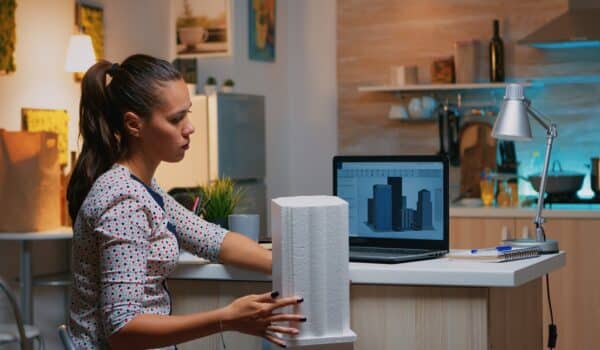You are busy taking notes in class and working with different software when the laptop stops responding. This wouldn’t have happened with the best laptop for architects since they have the necessary specs for smooth performance.
It’s a tricky situation to find yourself in because you can’t possibly ask the teacher to wait when they are explaining architectural designs. It also reflects poorly on your reputation as a student, which you can’t afford after years of coursework.
Architecture requires laptops that support the latest software and high-end applications for optimum results. Read our guide to know which laptops to choose and what specs matter for designing eye-catching projects.
Laptop Specs For Architecture Students

Choosing a powerful laptop is essential to run architectural software or to upgrade the unit based on new software releases. An architecture student is also required to create digital portfolios and learn rendering through Rhino or VRay.
This is on top of writing emails and letters for architecture work, so it’s critical to meet the latest software requirements to stay updated with the industry standards. Here we have listed the basic specs to help you choose a great laptop:
- Windows 10 or 11
- Nvidia Quadro, Nvidia GeForce 3060 or higher
- 16 to 32GB of RAM
- Intel i7 or i9 processor (at least 11th Gen)
- 500GB solid-state drive
- Theft and damage insurance
- Three-year warranty
- Wireless networking adapter
- 32GB USB thumb drive
- Large screen size
- USB storage hard drive, preferably between 500GB and 1TB
You can opt for mid-range Razer laptops, available as gaming laptops that meet most of these specifications. But sometimes, they are made of plastic and may not be durable.
It’s also possible to use the latest Macbook Air with M1 chips, but you won’t be able to run Windows via Bootcamp. Certain programs, like ArcGis, VRay for Rhino, and Environmental System software, may not work on these laptops. However, Rhino has a workaround since you can use Apple’s transition layer, Rosetta 2, to run it.
Architecture Software For A Professional Architect
As a working architect, you should know about various software packages to achieve the desired outcome on projects. The best laptop brands for architects update their software and operating systems based on the requirements of different architectural fields.
In this section, we have listed the common applications that architects need.
- Microsoft Windows packages, like Office, Excel, and PowerPoint.
- Adobe CC
- Rhino
- AutoDesk Suite
- Google Earth Pro
- Audrio
- Maya
- Processing
- Communityviz
- Final Cut Pro X
- Zbrush
- Inventor
- Revit
- Stata
- Google Sketchup Pro
- Geolytics
- Global Mapper
Things To Consider
In this section, we have looked at the essential features you can’t ignore when choosing the best laptops for architects.
1. GPU
Any laptop without a dedicated graphics card is of no use to an architect, so this should be your primary requirement. During your course as a budding architect, you will notice that many programs, such as Revit and Rhino, require a GPU to deliver the best results. It would be best to choose an AMD Radeon or NVIDIA graphics card, having at least 4GB VRAM.
2. CPU
Next, check whether the CPU can handle 3D modeling software and other high-end design tools, like the Asus Zenbook Pro laptops. Even the basic laptops for architects need to have a 4-core processor with a clock speed of 2.4GHz, so you should ideally aim for more than this. We believe that for multithreaded architecture tasks, a 6-core processor is a must.
3. Storage
People get confused between SSD and HDD storage but making a decision is easy. SSD is much faster than HDD storage, and your laptop should have sufficient SSD storage for the OS and running various architecture programs.
4. Connectivity
There should be multiple connectivity options so that you can even include an additional display when needed. The machine must have a DisplayPort, Thunderbolt 3/4, or HDMI port for such instances, which will help boost productivity.
What to look for in a laptop for architecture?
Certain things remain the same, be it laptops for professional architects or graduate students. The first thing to look at is the CPU because the latest processors support Adobe applications and 3D modeling to let you handle complex projects quickly.
We recommend a 4-core processor, having at least 2.4-GHz clock speed. But for multithreaded architectural design, it would be best to choose a 6-core processor with a dedicated graphics card.
Usually, a laptop with a GeForce graphics card, 16GB RAM, 2GB VRAM, and a Core i7 processor should suffice.
Should you use Mac or Windows for architectural work?
It ultimately comes down to your personal preference whether you choose Macbook Pro or Windows because both deliver the desired results. Many architects favor Windows ever so slightly since many architecture applications aren’t available on Mac. Even more important for architects is the lower cost and easy customization of Windows, which makes it convenient to upgrade them when needed.
Which is the best processor for architects?
One of the best processors for architects is the AMD Ryzen Threadripper Pro processor, which offers full-spectrum computation capability. It has 64 cores which makes it easier to run multithreaded tasks, but you will also find high-frequency cores to support single-threaded workloads. In other words, you can handle even the most demanding projects with this processor to ensure the design stands out.
Is a graphics card important for architecture software?
Graphics cards are extremely important for running architecture software and prove essential to improving the workflow and speeding up the design process. When you try to render the visualization, the graphics card will be dedicated to that process entirely to make things easier.
You can choose between NVIDIA or AMD graphics cards since they are fast and effective, but our preference would be the NVIDIA GeForce GTX 1080 Ti.
Will i5 be enough for architectural studies and projects?
Regarding mid-range processors, most standard laptops feature the core i5 processor since it’s quite powerful. However the problem is that it cannot run multiple demanding applications simultaneously and could lag. That’s why it will be fine for entry-level architectural tasks but not for advanced applications for which Intel Core i7 or i9 are better options.

Architecture students or professionals tend to opt for Windows laptops because most software is designed for Windows compared to other systems.
Apart from their wide range of options and greater compatibility, these laptops are affordable and suitable for multiple projects. Apple or Macbook Pro are other popular choices, but certain programs, like Revit and Microsoft Word, won’t run without Windows.
There’s also Chrome OS, but it hardly supports serious architecture projects since there’s no scope for using Adobe. So, choose wisely, and you should have a great time planning architectural designs!


